The wreck of the Endurance was found in 2022, and the 25,000 images captured at the scene have now been compiled into a detailed reconstruction of this historic ship.
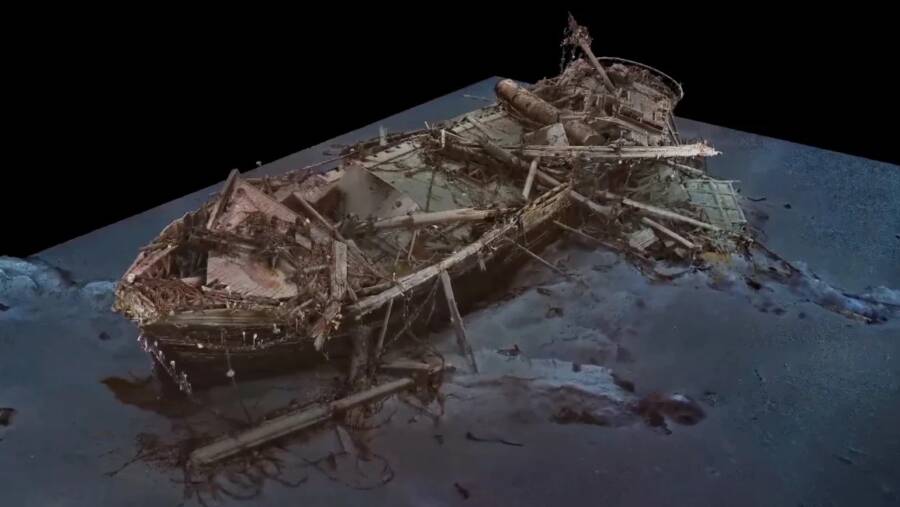
Falklands Heritage Maritime Trust/National GeographicThe detailed 3D scan of the Endurance, made up of 25,000 images.
In November 1915, Sir Ernest Shackleton’s ship, the Endurance, sank into the frigid waters of the Weddell Sea near Antarctica. Now, new images show how the ship has fared at the bottom of the ocean over the last 110 years in stunning 3D detail.
A digital scan of the Endurance was created using 25,000 high-resolution images captured when the shipwreck was first discovered in 2022. The ship, which rests nearly two miles below the surface, remains remarkably well preserved, and the new images even show tiny details among the debris on the ship’s deck, such as crew members’ dining plates and a flare gun.
That flare gun in particular became a focal point for researchers, as they linked it to the expedition’s photographer, Frank Hurley. In his diary chronicling the expedition and subsequent survival effort, Hurley wrote of a moment in which he fired the flare gun as the ship sank and then placed it back on the deck.
“Hurley gets this flare gun, and he fires the flare gun into the air with a massive detonator as a tribute to the ship,” Dr. John Shears, leader of the expedition that found the Endurance, told the BBC. “And then in the diary, he talks about putting it down on the deck. And there we are. We come back over 100 years later, and there’s that flare gun, incredible.”

Falklands Heritage Maritime Trust/National GeographicFrank Hurley’s flare gun, still resting on the deck of the Endurance.
Also seen for the first time in the wreckage is a knee-length boot, which researchers believe may have belonged to Shackleton’s second-in-command, Frank Wild.
“It’s absolutely fabulous. The wreck is almost intact like she sank yesterday,” said Nico Vincent of Deep Ocean Search, the organization that developed the technology used for the scans.

Falklands Heritage Maritime Trust/National GeographicAn image of the sunken Endurance, which was used to help create the 3D render.
The scans will be prominently featured in an upcoming National Geographic documentary about the sinking of the Endurance. This film also features AI in a fascinating way, recreating Shackleton and six crew members’ voices to “narrate” their own diaries, all of which brings the story to life in a way that has never before been possible.
The Doomed Voyage Of Ernest Shackleton And His Crew Aboard The Endurance

Frank Hurley/BFIErnest Shackleton aboard the Endurance.
In August 1914, Ernest Shackleton set out on an ambitious and perilous voyage to cross Antarctica. The Irish-born explorer had long been a passionate leader of expeditions to the South Pole, and he spoke extensively about his previous voyages, becoming a rather popular figure in the process.
So, he rallied a crew of sailors and researchers, then set out on the Endurance, a barquentine ship built to withstand extremely low temperatures. The ship initially set sail on August 8, 1914 from Plymouth, England, and reached the British-controlled South Georgia Island in late October. They finally set off for Antarctica on December 5, but they immediately began to face problems.
The rough, icy waters of the Weddell Sea quickly proved to be a fierce opponent for Shackleton’s crew. Then, in January 1915, disaster struck. The Endurance became lodged in thick ice, and for the next ten months, the crew made efforts to free their trapped ship. Finally, on October 27, 1915, Shackleton called for the crew to abandon ship. The Endurance succumbed to the pull of its watery grave and sank the following month.
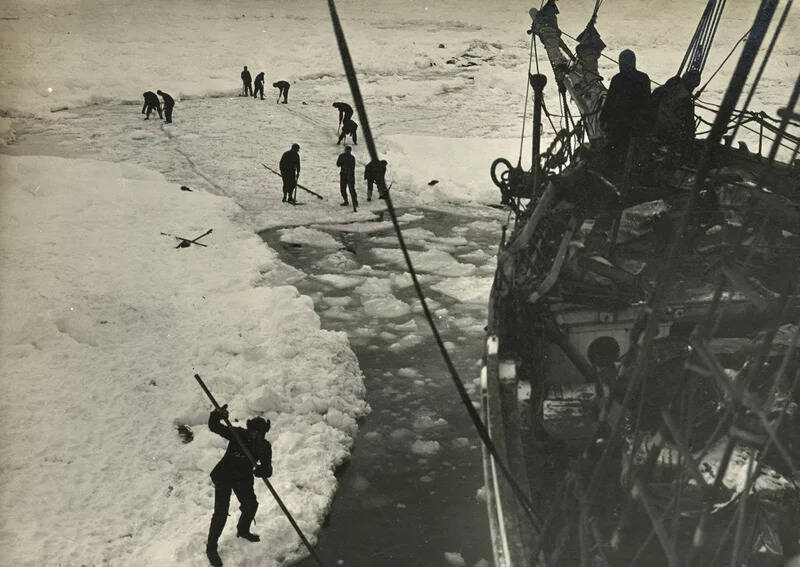
Frank Hurley/Scott Polar Research Institute, University of CambridgeThe crew of the Endurance attempting to free the ship from the ice.
The expedition was now no longer about exploration, but instead survival. Shackleton’s crew faced brutal conditions as they traveled across the ice on foot in hopes of an eventual rescue.
Finally, in April 1916, with the party now on Elephant Island, Shackleton and five crewmen set off in their lifeboat James Caird for South Georgia Island, leaving behind the other 22 members of their crew. Upon reaching South Georgia, they found a whaling party who could return to Elephant Island and rescue the rest of the crew.
And though getting back there to find those 22 crew members proved extremely difficult, Shackleton didn’t give up. At one point, he remarked, “If anything happens to me while those fellows are waiting for me, I shall feel like a murderer.”
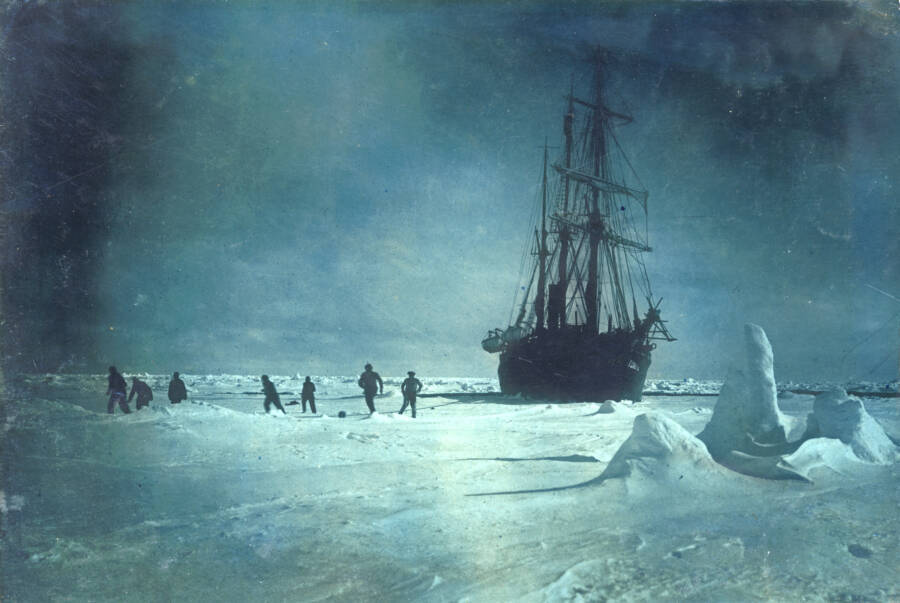
Frank Hurley/Scott Polar Research Institute, University of Cambridge/Getty ImagesThe crew of the Endurance playing soccer on the ice near the trapped ship.
But finally, four months later, Shackleton made it back to Elephant Island, where all 22 members were still alive and waiting for him. They all returned to London in October 1916, more than two years after they first departed. The story made headlines around the world, securing a spot in the history books for Ernest Shackleton and the crew of the Endurance.
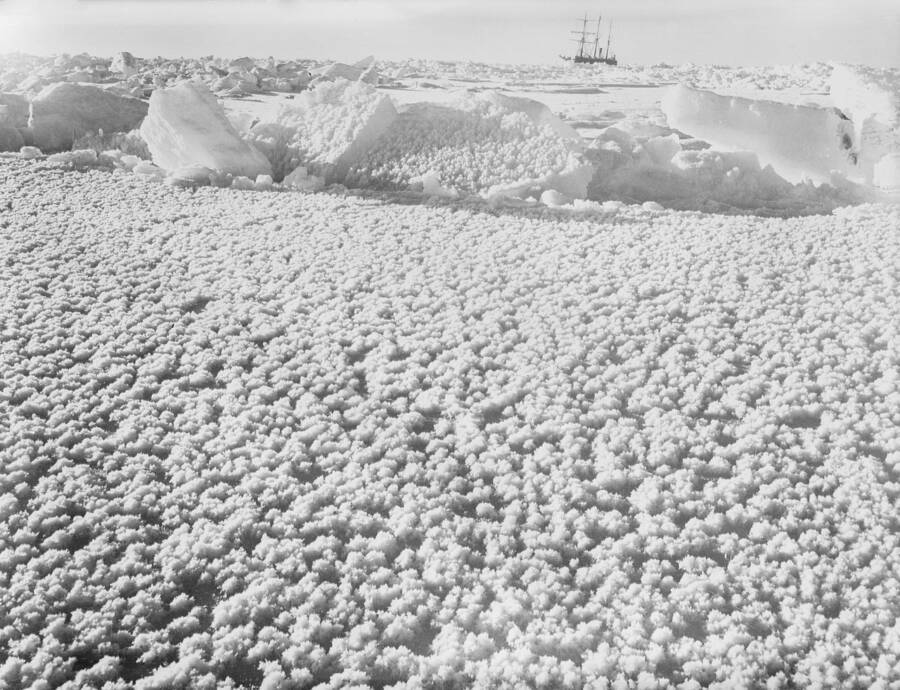
Frank Hurley/National Maritime MuseumThe Endurance in the distance after the crew was forced to abandon it.
Since then, there has naturally been much interest in Shackleton’s story and the fate of the Endurance, which prompted an expedition in February 2022 to find the wreckage of the ship. Using diaries of Endurance navigator Frank Worsley and data from the movement of the ice at the time of the original journey, members of the Endurance22 team were able to successfully locate the wreckage on March 9, 2022.
The team then captured thousands of high-resolution images of the ship, which have now been compiled into stunningly detailed 3D scans of the ship.
A First Look At The Endurance Since Its Sinking In 1915
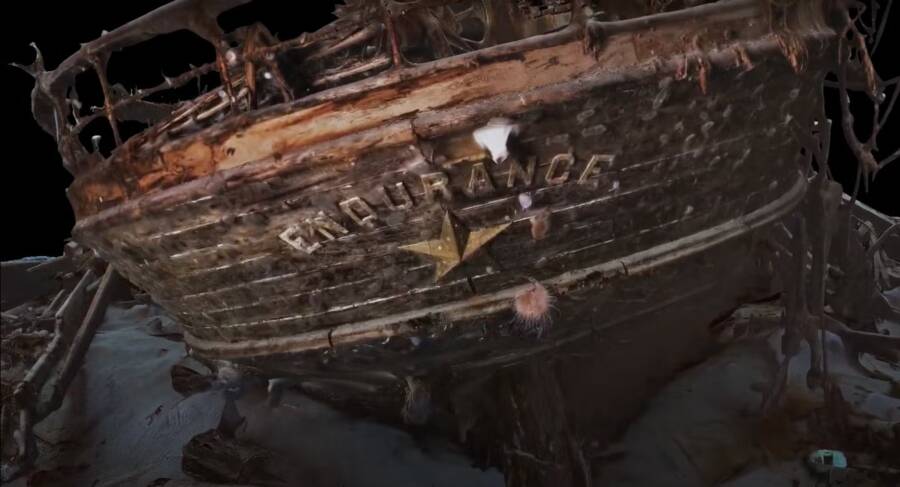
Falklands Heritage Maritime Trust/National GeographicA scan of the bow of the Endurance.
At the time of the discovery, Marine Archaeologist and Director of Exploration Mensum Bound wrote in his blog: “She is upright, well proud of the seabed and in an excellent state of preservation. You can even see her paintwork and count the fastenings. There is some damage to the fo’c’sle deck and part of her starboard side, but otherwise she is largely intact.”
Some photographs taken during the expedition were released at the time, but none offered quite as extensive a look as the newly released 3D renders of the vessel.
The images show just how well preserved the Endurance is after all these years. Most of the ship’s structures are still intact, and small details like dinner plates, the flare gun, and a boot can be seen among the debris. The high-resolution images even show small details like grooves carved into the sediment as the ship came to a halt on the sea floor.

Falklands Heritage Maritime TrustA crewman’s boot laying on the deck of the Endurance.
Furthermore, researchers believe this revolutionary rendering process could be used in countless scientific studies going forward. Deep Ocean Search’s Nico Vincent, who was also a co-leader of the expedition, said the Endurance scan could be used by biologists to study any sea life that has colonized the wreckage, or by geologists to study the sea floor and potentially discover new artifacts.
“This is really a great opportunity that we can offer for the future,” he said.
The team said they have no plans to raise the Endurance, and it is unlikely that any future expeditions will be made to see the ship again, due to its dangerous and remote location. Still, the sole trip out provided a wealth of new information about the Endurance, and the documentary which premieres October 12 at the London Film Festival should breathe even more new life into this historic tale.
After reading about this 3D reconstruction of Ernest Shackleton’s ship, learn about the true story of the Andrea Gail. Then, read all about the sinking of the RMS Titanic.





